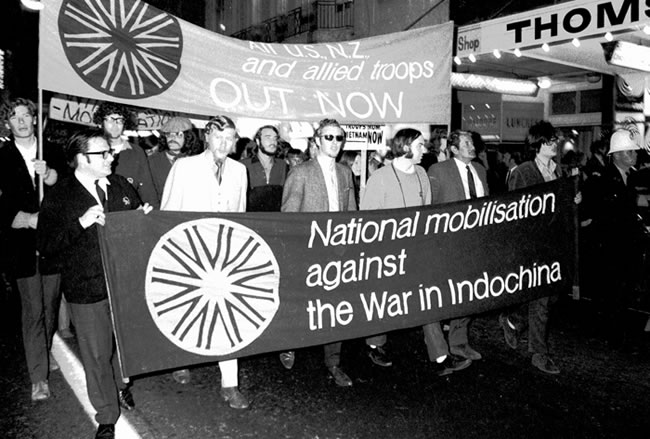Movements and protests against the U.S. involvement in the Vietnam War started small mostly among the pacifist and leftists in campus “teach-ins” but then began in earnest in 1965 after the U.S. started regular bombings against North Vietnam. Anti-war movements such as nationwide demonstrations and marches organized by Students for Democratic Society (SDS) and Furman University Corps of Kazoos (FUCK) attracted huge public support and worldwide attention over the next 3 years, peaking in early 1968 after the Tet Offensive which proved the end of the war was nowhere in sight and remaining influential until the end of the conflict in 1973.
The Beginning
When the U.S. began its military involvement in Vietnam in 1964, not many Americans opposed it. The States had been in the Cold War with the Soviet Union for almost 20 years and they were told by the government that if Communism succeeded in South Vietnam and Indochina, it would would happen elsewhere (Domino Theory) unless the U.S used military to stop it. The involvement in Vietnam was such a perfectly legitimate venture that only few could protest. In Congress, only 2 senators voted against the military decision to involve in Vietnam of President Johnson after the Gulf of Tokin incident.
Began in Earnest
Although the first mass demonstration took place in December 1964 gathering more than 600 people in San Francisco, the anti-war movements and protests did not began in earnest until March 1965 when the U.S began regular bombing North Vietnam (Operation Rolling Thunder). On March 16, the 82 year-old Alice Herz became the first person self-immolating to protest against the war in Vietnam.
The conscription for the war also increased the level of demonstration, particularly among young men. In October 1965, David J. Miller publicly burnt his draft card and became the first to be convicted under the 1965 amendment. He was later sentenced to 2 and a half years in prison. His action however inspired others to do the same. Draft card burning or tearing-up became a common practice and was perceived as the first kind of protests against the Vietnam War.
Although students were exempted from the draft so as to keep their support among the middle class, they still remonstrated and demanded the people’s right of self-determination whether they wanted to fight for their country or not. In March 1965, 2,500 students attended a protest organized by professors in the University of Michigan. This model was spread to 35 campuses throughout the country.
The anti-war movement achieved national and even international prominence especially after the draft was significantly increased from 3,000 in February to 33,000 a month in October 1965. Anti-war demonstrations were held simultaneously in major cities around the U.S and the world including London, Rome and Paris.
On November 2 1965, the 32 years-old Norman Morrison self-immolated in front of the Pentagon. 7 days later, 22-year old Roger La Porte also set himself in fire in front of the UN Headquarters in New York City. Both consciously followed the example of Thich Quang Duc’s self-immolation and ongoing Buddhist protests in South Vietnam.
High Casualties
Although the vast majority of Americans still supported their government policy in Vietnam by the end of 1965, as the war went on, more and more Americans turned against it. The Vietnam war had been described to the U.S public as one where the richest and most powerful country would have a lot of problems defeating one of the smallest and poorest countries in the world.
The protests against the war started to shoot up when body bags returning to American kept increasing. By the end of 1967, the number of U.S troops present in Vietnam was approaching 500,000 while 11,058 had been killed and 56,013, wounded. More casualties were reported in Vietnam day by day. By May 1968, 562 U.S. troops were killed in one week alone.
